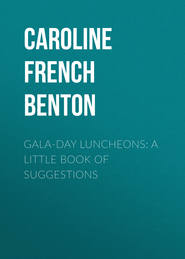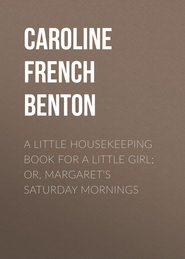По всем вопросам обращайтесь на: info@litportal.ru
(©) 2003-2024.
✖
The Complete Club Book for Women
Настройки чтения
Размер шрифта
Высота строк
Поля
What can be done to rid the town of flies and mosquitoes in summer? As to the schools, cannot manual and vocational training be secured? Are open-air schools needed? Cannot music and art be better taught? Is there any place in town which affects good morals?
Is it possible to establish a rest room for farmers' wives who come to town? Are coffee rooms needed to supplant the saloon?
Remember that children are always delighted to help in community improvement, and will investigate conditions as to alleys, playgrounds, or help clean up the town.
Much legislation on many of the topics will come up. A lawyer may be asked to come into the club and talk about the state laws, child labor, or any of the other subjects under discussion. Indeed college professors, school superintendents and teachers, settlement workers, physicians, clergymen, librarians, mill owners, theatrical managers and editors may all be asked to help on this great work of community improvement, and they will be found to respond gladly. The whole population will gradually be drawn into touch and made to assist in the great project of transforming the home town into an ideal spot in which to live and bring up a family.
III – BOOKS FOR REFERENCE
Among the many books to be had are these:
"Knowing One's Own Community," Carol Aronovici. Social Service Series, Bulletin 20 (National Municipal-League Series, Appleton); "The Country Town," W. L. Anderson (Doubleday, Page & Co.); "Village Improvement," Parris T. Farwell (Sturges and Walton); "Re-planning Small Cities," John Nolen (B. W. Huebsch); "American Municipal Progress," Chas. Zeublin (Macmillan Co.); "The Improvement of Towns and Cities," C. M. Robinson (Putnam); "American City Government," Chas. A. Beard (Century Co.); "American Playgrounds," E. B. Mero (American Gymnasia Co., Boston); in the Woman's Citizens' Library, edited by Shailer Matthews, there are excellent articles on most of the above topics. (Civics Society, Chicago.) Bulletins of Department of Social and Public Service are excellent. (American Unitarian Association, 25 Beacon St., Boston.)
"Social Forces," Miss L. E. Stearns. (Capitol Bldg., Madison, Wis.) Remarkable list of books on all subjects needed.
American Civics Association; pamphlets on all subjects needed. (Union Trust Bldg., Washington, D. C.)
There are many magazines dealing with out-of-door life which have articles on good roads, tree planting, gardens and playgrounds. Survey has others on child welfare in all its aspects, settlement work, etc. The Chicago and New York Schools of Philanthropy also have pamphlets, and will send any information.
CHAPTER III
A Study of the American Colonies
To study the American colonies thoroughly clubs should spend twenty or more meetings upon them. There is abundant material suggested here to enlarge the ten meetings outlined to that many at the very least.
The best way to arrange the club work is to give at least four meetings to Virginia, four to New England, two or three to New Netherlands and two to each of the other important colonies.
In preparing papers, see "The Thirteen Colonies," by Helen A. Smith (Putnam), "Romance of American Colonization," by William E. Griffis (Wilde), and the series on the colonies, one volume on each, by John Fiske (Houghton Mifflin Co.). See also the first part of "America," by H. Butterworth (The Page Company).
Before beginning the study of the first colony, Virginia, there should be one meeting on the England of that time. Sir Humphrey Gilbert, Sir Walter Raleigh, and Drake should have special attention.
I – VIRGINIA
Describe the first expedition to Virginia; have an account of the settlement at Roanoke, then of the second expedition which brought over a hundred and fifty men and seventeen women, and its fate, and then the death of Raleigh and the pause in the spirit of colonization. The meeting following this will then begin the next period, when under King James colonization was again taken up. A paper may be on the settlement of Jamestown, a second on John Smith and his work, and a third on the "starving time," the trouble with the Indians, the coming of supplies from England. Close with a presentation of the conditions of the new colony, its mismanagement and loss of life.
The "era of progress" comes next in order, from 1610 to 1624. Have sketches of Lord Delaware, Sir Thomas Gates, and Sir Thomas Dale; mention the group of new settlements and note their military character. Bring in the story of Powhatan, and of Pocahontas and her important marriage. The growing value of tobacco in England, the importation of negro slaves, the rise of burgesses, the coming of indentured servants, of poor immigrants, and of wives for the colonists are all important topics; close with an account of the great massacre.
Discuss the coming of the cavaliers to America. Was their influence good? Speak of the consequent loss of a thousand Puritan colonists from Virginia, and its effect.
The curious political development of Virginia should be studied. Note the importance of courts, and describe "court day." The next great point to be taken up is the first colonial tragedy – Bacon's rebellion. Describe the causes which led up to it; have papers on Berkeley, the tobacco riots, the Indian outbreak, the romantic figure of the "Queen of Pamunkey," the arraignment of the Governor, the burning of Jamestown, the death of Bacon, and the far-reaching results of the rebellion. Read from "White Aprons," by Maud Wilder Goodwin (Little, Brown & Co.), and "The Heart's Highway," by Mary Wilkins Freeman (Doubleday, Page & Co.).
Follow with a study of a century of development in Virginia. Read of Lord Culpepper, of the founding of William and Mary College; mention the absentee governor and his famous lieutenant governor, Sir Francis Nicholson, who first suggested the possible union of the American colonies. Read also: "King Noanett," by F. J. Stimson (Scribner), and "Old Virginia and Her Neighbors," by John Fiske (Houghton Mifflin Co.).
II – MARYLAND
The history of the colony of Maryland is closely connected with that of Virginia. Take the story of the Calvert family, beginning with the first Lord Baltimore. Follow the topic with the coming of Dutch and Swedish colonists, the sending of Herman by Stuyvesant to Maryland and his interesting career.
The important point to notice in all this is the establishment of the manor system. Compare it with the vestries of Virginia, and later compare both these with the patroon system of the Dutch, and the town meeting rule of New England.
Have a paper on the fifth Lord Baltimore and the changes which followed his accession. Read from "Mistress Brent," by Lucy M. Thruston (Little, Brown & Co.), and "Sir Christopher," by Maud Wilder Goodwin (Little, Brown & Co.).
One entire meeting should follow next on the manners and customs in the Southern colonies. See "Some Colonial Homesteads," by Marion Harland (Putnam), and the chapter in Fiske on customs in "Old Virginia and Her Neighbors."
III – NORTH AND SOUTH CAROLINA
North Carolina, the next colony on the south to Virginia, was settled largely by refugees, who, discontented at home, came here from other colonies. Read from the visit of George Fox the Quaker, of the difficulties of travel and of the poverty and need of the people.
Colonel James Moore, who came to the help of the people, should have one paper, and Governor Eden another. Read also the extraordinary story of the pirate Blackbeard, the terror of the coast, and his relations with the governor.
After many vicissitudes colonists of the better sort began to arrive, and slowly the colony prospered.
South Carolina, unlike North, was from its beginning settled by rich planters, slave holders, of distinctly aristocratic habits. Read of Carteret, West, and Sir John Yeamans, and of the constitution known as the "Grand Model," drawn up by John Locke.
Charleston was made the capital in 1681, laid out at the beginning by Culpepper with sites for churches, a town house, an artillery ground and wharves, and at once it became an important place.
The trouble with the Spaniards on the south, and the siege of Charleston by Blackbeard make two excellent topics for papers; a third is the wise government of Nicholson for twenty-five years.
IV – GEORGIA
Georgia, the most southerly of the colonies, is famous because of one man, James Edward Oglethorpe, the soldier, statesman, and philanthropist. He planned to make it a refuge for all persecuted Protestants of Europe, one where debtors of good family could come and make an honest living, and where criminals might begin life anew; it was to be the poor man's paradise.
One hundred and fourteen persons came over with him, and in six weeks Savannah was laid out, and clearing and building begun. The story reads like a romance. All went well till lazy and shiftless immigrants arrived to enjoy the paradise also. Oglethorpe returned to England for a time, taking several Indian chiefs with him. Read of their visit to court. He returned with John and Charles Wesley.
But trouble with Spain was at hand; war followed, and Oglethorpe again went to England and never came back. Slave holding, before prohibited, was now permitted; plantations grew up, commerce developed, and an era of prosperity was established. Read "Doris Kingsley," by Emma Rayner (Small, Maynard & Co.).
V – THE NEW ENGLAND COLONIES
Before turning to the north, to the study of the New England colonies, clubs should take rather thoroughly the history of England in the seventeenth century and familiarize themselves with conditions there, and also in Holland.
After this will come the well-known story of the voyage of the Mayflower, the landing of the Pilgrims, and the establishment of the first little settlement. Read of the leaders, John Carver, William Bradford, Standish, Winslow, and Alden, and of the first winter.
The great advantage Massachusetts had over all other colonies lay in the fact of the great Puritan emigration from England. Earnest, intelligent, devoted people of high ideals made up the great bulk of the settlers.
Note the fact of the growing religious intolerance of the Puritans; one meeting may be spent on this topic. Speak of Ann Hutchinson and Roger Williams, the harsh treatment of the Quakers, and of witchcraft. Have readings showing how the belief in the last grew, and its terrible results. Read from Hawthorne's "Scarlet Letter."
Next take these New England colonies in the order of their settlement, New Hampshire, Connecticut, and Rhode Island, and show the differences in them.
Notice how, in Massachusetts, the vote was given to church members only, while in Connecticut it was given to all citizens. Read of education in New England, of schools, of the founding of Harvard and Yale colleges. Have a paper on Cotton Mather, Thomas Hooker, and Davenport. Describe the Town Meeting. Have a paper also on the Indians, and discuss the Pequot War, the Deerfield Massacre, and similar events.
Close this study with an appreciation of the character of the men and women of New England. Read from "Men, Women and Manners in Colonial Times," by Sidney G. Fisher (Lippincott), "Customs and Fashions in Old New England," by Alice Morse Earle (Scribner), "Home life in Colonial Days," and "Child Life in Colonial Days," by the same author (Macmillan), and "Soldier Rigdale," by Beulah M. Dix (Macmillan). Several meetings may take up furniture, pewter, china, silver, old coverlets, embroidered linen, and the like. Read "The Quest of the Colonial," by Robert and Elizabeth Shackleton (Century Co.), and "Colonial Furniture in America," by L. V. Lockwood (Scribner).
VI – NEW AMSTERDAM
Between New England and Virginia lay several colonies, the most important, New Amsterdam. Preface its study with one paper on Holland at the time. Then describe the coming of the little Half Moon, the voyage up the Hudson, and the friendliness of the Indians shown here, as in each of the different colonies at the beginning of their history. Three settlements were soon made, one at Fort Orange, now New York, one at Fort Nassau, now Albany, and a third in New Jersey across from Fort Orange. Tell how in a few years there were farms with stone houses, churches, schools, and a regular system of fur trade with the Indians which brought in huge yearly revenues. Three papers may be on the governors Minuit, Van Twiller, and Kieft, noting their unlikeness, and what each accomplished. A fourth paper may describe the patroon system and compare it with that of other colonies.
The interesting figure of Stuyvesant, and his times, in New Amsterdam, should have a meeting. Others may take up the coming of negro slaves, the establishment of settlements on the Hudson, the trouble with Long Island and its English settlers, the appearance of the English fleet, the surrender of New Amsterdam, and the taking of the oath of allegiance.
Have a description of life in Dutch New York and Albany and on Long Island. The famous siege of Lady Moody's house at Gravesend and its defense by forty Englishmen is also of interest.









